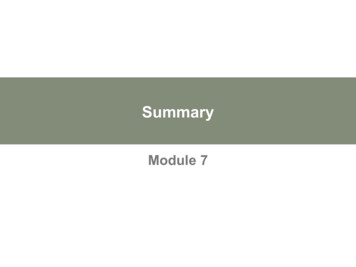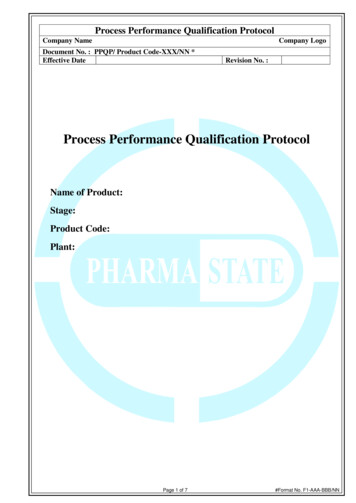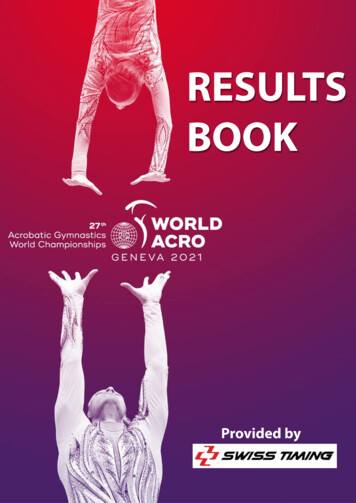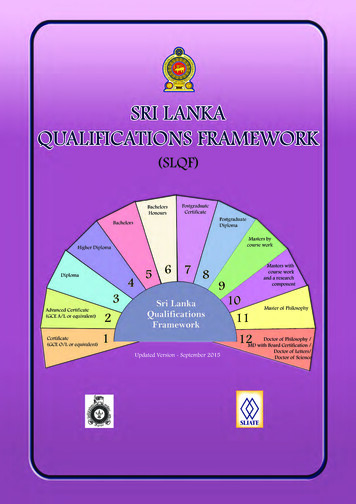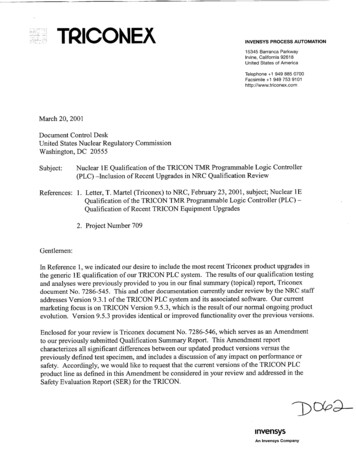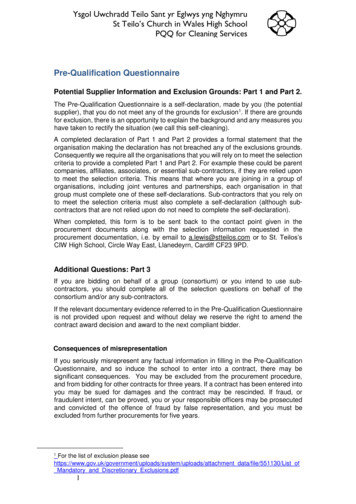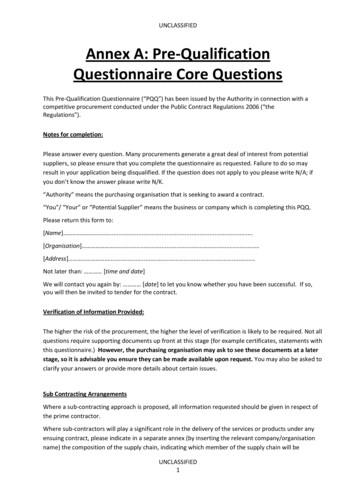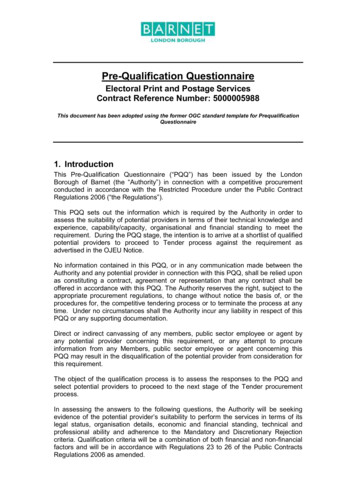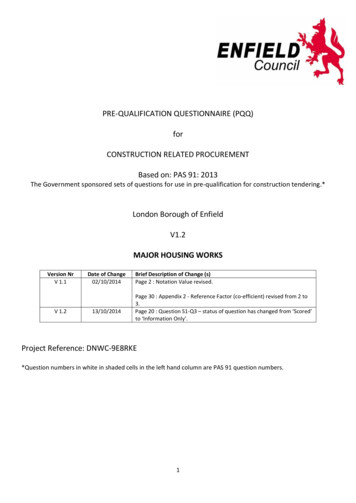
Transcription
Qualification of High-Strength Linepipes for Hydrogen Transportationbased on ASME B31.12 CodeA. S. Tazedakis, N. Voudouris, E. Dourdounis; G. Mannucci, L. F. Di Vito, A. Fonzo Corinth Pipeworks SA; RINAConsulting – Centro Sviluppo Materiali SpAAbstractA number of CPW manufactured HFW and SAWL pipes were tested for fracture toughness properties in high pressure 100% hydrogen environment. All tests were performed in RINA laboratory, following a developed test procedurebased on code ASME B31.12 Option B (qualification of the material threshold stress intensity factor KIH).Testing involved API 5L grades of quality X60M to X70M, with a hydrogen test pressure of 80bar and varying applied stress intensity factors 110-145 MPa· m.Following a test exposure of 1000h, all parent material, weld and HAZ specimens presented an excellent resistanceto hydrogen embrittlement showing no measurable crack propagation from the fatigue pre-crack front.Based on the results, a KIH value of 55 MPa· m and above was established in all cases, fulfilling the minimum qualification criteria of ASME B31.12 Option B
PIPELINE TECHNOLOGY JOURNAL 43RESEARCH / DEVELOPMENT / TECHNOLOGY1. INTRODUCTIONHydrogen is the most environmentally friendly carrier ofenergy: when consumed it solely emits water. Energy carrier means that its potential role has similarities with that ofelectricity. Both hydrogen and electricity can be producedby means of various energy sources and technologies.Both are versatile and can be used in many different applications. No greenhouse gases, particulates, sulfur oxidesor ground level ozone are produced from the use of eitherhydrogen or electricity [1].Conversely, hydrogen can be produced in an environmentally sustainable way by using only water and energy. Thisexcellent energy solution requires however currently costlyelectrolysis equipment and is accompanied by a substantialenergy loss during the extraction process. Nevertheless,also under this aspect, R&D efforts are producing importantresults with more efficient and cost effective electrolyzersavailable in the near future [2].Consequently, hydrogen is currently enjoying unprecedented political and business momentum, with the number ofpolicies and projects around the world expanding rapidly; inJuly 2020, EU Commission adopted a new dedicated strategy on hydrogen in Europe: the strategy explores actions tosupport the production and use of clean hydrogen, focusingin particular on the mainstreaming of renewable hydrogen.The strategy highlights a condition for a widespread use ofhydrogen as an energy carrier in the EU is the availabilityof energy infrastructure for connecting supply and demand,and this can be done in a cost effective way via pipeline.Hydrogen offers ways to decarbonize a range of sectors,as well as helps improve air quality and strengthen energysecurity. Although hydrogen can be produced from a widevariety of fuels, its greatest potential lies in assisting withvariable output from renewables, like solar photovoltaicsand wind, whose availability is not always well matchedwith demand. As a result, hydrogen is one of the leadingoptions for long term storing of converted electricity.The production of hydrogen from renewables can beachieved at lower cost in regions with abundant solar andwind resources. For large volumes and long distances,transportation via pipelines to large energy consumers isthe most financially attractive alternative [3] [4]. Additionally, blending hydrogen into natural gas has been proposedas a mean of delivering pure hydrogen to markets, by usingseparation and purification technologies downstream inorder to extract hydrogen from the natural gas-H2 blendclose to the point of end use [5]. Blending hydrogen wouldprovide a boost to hydrogen supply technologies withoutincurring the investment costs and risks of developing newhydrogen transmission and distribution infrastructure. [1].The recent interest in developing a hydrogen-based energyeconomy resulted to the need for hydrogen compatiblematerials to the forefront, especially dealing with the effectof Hydrogen Embrittlement (HE). HE is the degradationof the mechanical properties of a metal, most frequentlymanifested by the emergence of low energy fracture mechanism when exposed to hydrogen.The phenomenon of HE has been recognized since 1875[6] and has been extensively studied. While the fundamental mechanism behind HE is a matter of continuousinvestigation from the scientific community, the amount ofdata on the effect of hydrogen on mechanical properties ofdifferent metals and alloys made the standardization of appropriate materials possible, for a number of applicationsinvolving gaseous and liquid hydrogen systems. [7].2.STATUS OF CARBON STEELHYDROGEN LINEPIPESThe transport of gaseous hydrogen through pipelines hasbeen realized by use of mild carbon steel for almost acentury and it is estimated that there are over 4,500 kmof hydrogen linepipes in operation worldwide [8]. Typically, hydrogen linepipes are designed to transport gasover only short distances, from the production facility tothe end user. Many such applications operate with a verygood safety record but at maximum pressures which areconsiderably less than the ones that would be requiredfor long-distance pipeline transmission of hydrogen [9]. Inaddition, typical pipeline size is 300mm or less, manufactured with X52 or lower strength steels [10] and in comparison to natural gas, H2 pipelines normally operate atrelatively conservative conditions.However, owing to the low volumetric energy density ofhydrogen (0.0108 MJ/L) in comparison to natural gas(0.0364 MJ/L) and the forecasted expansive utilization ofrenewable energy sources mentioned in section 1, it will benecessary to transmit hydrogen at high pressures usinglarge size pipelines in order to be financially competitive.The combination of high pressure and large size pipe demands the use of higher strength steels.The advantages of specifying a higher grade line pipe fortransportation of hydrogen or hydrogen-gas mixtures canbe substantial: According to independent analysis [11], fora baseline scenario using a 24’’ HFW longitudinal pipe operating at 1,500psi (10.34MPa), the use of X70 material canresult into cost savings up to 31% relative to the use of X52.The amount of published results on the effect of hydrogen to the mechanical properties of higher grade API linepipe steels under high pressure is rapidly increasing and
44 PIPELINE TECHNOLOGY JOURNALRESEARCH / DEVELOPMENT / TECHNOLOGYresults of systematic work have been presented by NISTand Sandia National Laboratories. According to publishedwork [10] [12], a number of toughness tests on API carbonsteels have shown that the absolute fracture toughnessremained high under high pressure hydrogen conditions,even though it was lower than respective measurementsin air or inert gas. In addition, a comprehensive testingprogram to determine fatigue crack growth rate of pipelinesteels in pressurized hydrogen gas verified no change inFCGR (Fatigue Crack Growth Rate) with increasing yieldstrength up to X100 [13].K. Xu [10], reviewed a number of published results forcarbon steels up to X70 and 10.3MPa test pressure whentested under static loading condition and no subcriticalcrack extension was exhibited under various loadingconditions. The same report presents also a numberof rising load method fracture toughness KJC tests formicro alloyed steels up to X80 in 6.9MPa H2 where themeasured fracture toughness was found above to be 95MPa m1/2 in all cases. San Marchi et al [12] [14] reportedalso fracture toughness values in the range of 80 to 100MPa m1/2 using a rising load test method in high pressuregaseous hydrogen (5.5 and 21MPa) for two X60 and X80pipeline steels.In comparison to plain carbon ferritic steels, API 5L steelsof higher grade typically contain additional alloying elements, such as small quantities of niobium and titanium.These “microalloying” additions as well as processingby thermomechanical rolling provide a combination ofelevated strength with excellent low temperature fracturetoughness. In metallurgical terms, many modern highergrade API 5L steels utilise a ferrite/bainite or ferrite/acicular ferrite microstructure to attain these properties. Thelower pearlite volume fraction of these steels is consideredto provide enhanced hydrogen resistance, an effect obtained by reducing the amount of H2-trapping sites i.e. theinterfaces between microstructural constituents [15] [16].3.briefly described hereinafter.It is worth highlighting EIGA report makes specific suggestions to limit the effects of hydrogen embrittlementon materials, such as appropriate material classes, compositional and strength limits, and suggests appropriatetesting methods, but is a recommended practice and nota standard. At the same time, new ISO standards underrevision are expected to follow the ASME B31.12 approachfor the material qualification of pipelines for high pressuregaseous hydrogen transportation; ASME B31.12 is now themost used standard for material qualification and can beexpected to be the reference one also in the next future.4.ASME B31.12 CODEThe ASME B31.12 Hydrogen Piping and Pipeline Code [17],has been initially published in 2008, in order to deal withdesign, construction, operation, and maintenance requirements for piping, pipelines, and distribution systems inhydrogen service. The B31.12 committee has developed twodesign methods that can be considered in conjunction withsteel/piping specifications (i.e. API 5L PSL2) and acceptable manufacturing routes for welded pipes (HFW, SAWLor SAWH) [15].The first (Option A) is prescriptive and similar to designprocesses contained in ASME B31.8 Natural Gas PipelineCode. It considers the use of lower basic design factors,F, and a material performance derating factor, Hf, derivedfrom pressure and tensile strength relationships.The second (Option B) is performance based, using a fracture mechanics approach (on the basis of ASME SectionVIII, Div. 3 - Alternative Rules for Construction of HighPressure Vessels). The qualification of the pipeline materials is performed by use of fracture mechanics and crackpropagation testing that empowers the use of enhanceddesign factors and withdraws the limitations on pressuredue to the use of the Hf derating factor.APPLICABLE STANDARDS AND PRACTICESThere is a limited number of standards that can be usedfor material qualification for pipeline gaseous hydrogentransportation: International European standardization bodies areworking in revising EN 1594, EN 16348 and EN 12732 inorder to consider H2 and H2NG mixtures also. EIGA (European Industrial Gases Association) published a document (IGC Doc 121/14) which recommendsmaximum steel grade to be used and suggests testingto be carried out, but with not specific instructions onhow to qualify the material. ASME B31.12 is a US standard for material qualificationfor use with H2 and H2NG mixtures. Two basic approaches are adopted: Design Option A and B, that areIn regards to the second design method, the code introduces additional requirements for pipe material, related tolower Phosphorus content ( 0.015%) and considerationof API 5L Annex G for CVN testing (Enhanced DuctileFracture Propagation Properties). More specifically, theASME B31.12 code requires that the threshold stress intensity factor for hydrogen-assisted cracking (denoted asKIH) should be measured according to ASME VIII [18] andASTM E-1681 [19].When designing a pipeline for hydrogen transportation, thebenefits of compliance with ASME B31.12 Option B can besubstantial. This is illustrated in Figure 1 for an API X60Mgrade: the design factor for Option B can be 72% of thespecified yield strength for all applicable pressures up to
PIPELINE TECHNOLOGY JOURNAL 45RESEARCH / DEVELOPMENT / TECHNOLOGY20.7 MPa (3,000 psi). On the contrary, the same designfactor for Option A is limited to a maximum yield strengthpercentage of 43,7% or even lower, due to additional limitations of the material performance (Hf ) factor when thedesign pressure approaches 3,000 psi (20.7MPa).The latest version of ASME B31.12, specifies for Option Bthat fracture toughness qualification testing is requiredto validate the minimum threshold stress intensity factor(KIH) at the design pressure and 100% H2 concentration.The test on the pipes should be performed at the base metal, weld metal and heat affected zone positions, on threeheats of the pipe material. It is highlighted that the testsqualify also other materials with similar chemical composition and tensile properties (Yield and Tensile Strength) upto 5% higher than the qualified ones. Therefore, samplesshould be selected from the upper end of the tensile properties distribution. The KIH value that qualifies the materialin accordance with ASME B31.12 Option B is 50ksi in1/2(or 55 MPa m1/2) unless otherwise specified by designanalysis. It should be noted that the latest version of theASME B31.12 code has removed the requirement to performspecific FCGR testing for the qualification of a hydrogenline pipe and generic curves are provided, applicable for allcarbon steels in gaseous hydrogen up to 20.7 MPa (3,000psi) service pressure.5.FRACTURE TOUGHNESSQUALIFICATION TESTINGAimed at validating the performance characteristics ofhigh grade API 5L pipes in pressurized hydrogen, CPWorganized a number of fracture toughness qualification(KIH) tests under the ASME B31.12 code Option B scheme,including both High Frequency Welded (HFW) and Longitudinal Submerged Arc Welded (SAWL) pipes. All testedpipe material is presented in Table 1. As presented in FigureFigure 2: CPW HFW 26’’ mill product range (yellow points: tested pipes)Figure 1: Design pressure factors for X60M for Option B vs Option A in areascharacterized as Location Class 1, Division 22, the selected pipe dimensions for the HFW pipe, belongto the upper diameter and thickness segment of the 26’’mill’s product range. All the tests were carried out at roomtemperature (around 15 C).6.PROCEDURE FOR KIH TESTINGASME-based hydrogen material tests were performedin RINA Consulting – Centro Sviluppo Materiali SpA, anacknowledged European Company specialized in thedevelopment of new materials and in the performanceassessment of materials and equipment in new operatingwindows; with regard to the subject, RINA has specificskills and laboratories specialized to evaluate materialsand components performance in presence of gaseoushydrogen up to 1,000bar external pressure.Fracture toughness testing protocol in pure hydrogengaseous environment was determined in terms of KIH forall notch positions in compliance with ASTM E1681 [19]
46 PIPELINE TECHNOLOGY JOURNALRESEARCH / DEVELOPMENT / TECHNOLOGYTable 1: Overview of CPW pipes tested for fracture toughness (KIH) in pressurized hydrogenaccording to the constant displacement configuration, withthe additional prescriptions of ASME B31.12 [17] and ASMEBPVC Section VIII, Division 3 [18] [20].The procedure for KIH fracture toughness testing is presented schematically in Figure 3.Samples are machined in bolt-load compact configurationin compliance with the prescriptions of ASME E1681 [19] forthe Modified bolt-Load, Compact Specimen; H/W 0.486,where W/B is 2:1 (Figure 4). No pipe flattening was applied prior to sample machining and the largest possiblethickness was obtained depending on pipe curvature. Inany case, the request of having at least 85% of the pipenominal thickness was always satisfied.Figure 3: Outline of KIH testing procedureThe determination of the threshold stress intensity factorinvolves a specimen containing a machined notch, whichis placed in base material and, for HFW pipes, in bond lineor, for SAWL pipes in weld metal and Heat Affected Zonecrossing the fusion line (Coarse Grain HAZ) at the maximum extent. This notch is extended by fatigue crackingunder controlled conditions for maximum loading, especially for the final part of the crack growth. The fatigue precracked specimen is then placed in a glovebox filled with anitrogen atmosphere, under very low oxygen and moisturelevels as required per ASME code.The specimen is then loaded by means of a bolt to theattainment of the target Crack Mouth Opening Displacement, established on the basis of the target stress intensity
PIPELINE TECHNOLOGY JOURNAL 47RESEARCH / DEVELOPMENT / TECHNOLOGYAfter the specified test period, the specimen is examinedto assess whether the initial fatigue crack did or did notgrow. The specimens are heat tinted and broken open inliquid nitrogen. The fracture surface is then examined byoptical observation and scanning electron microscope.Measurements of the crack front extent are taken in fivepositions and the average crack growth in hydrogen iscalculated.7.FRACTURE TOUGHNESS KIHTEST RESULTS AND EVALUATIONFigure 4: Compact tension specimens in RINA laboratoryKIAPP for plain strain conditions. According to the code,the applied KIAPP should be at least 1.6 times greaterthan the estimated KIH but not more than 180 ksi· in (198MPa· m). After loading, the samples are put inside the testchamber which is sealed while still inside the glove box,preventing any contact of the loaded samples with atmosphere oxygen and moisture.The test chamber is then charged with pure hydrogen gasat the target test pressure and maintained at this pressurefor 1,000h. In this way, any fresh crack surface that is possibly generated by ductile tearing during bolt loading hasnever been exposed to oxygen or moisture and is henceprone to hydrogen permeation from the gaseous hydrogenenvironment.Table 2: Results of fracture toughness ASME KIH testingThe results of all validated fracture toughness KIH tests aresummarized in Table 2. Four samples per material/notchwere prepared in order to obtain at least three valid resultsper position. According to KD-1047 clause of ASME code[18] for the constant displacement method, if the averagemeasured crack growth does not exceed 0.01 in. (0.25mm)KIH is equal to 50% of KIAPP. Taking this clause intoconsideration, the KIAPP initial stress was selected to beat least double of the minimum threshold stress intensityvalue required by the code of 55 MPa· m.No hydrogen crack growth was noticed at any specimenafter visual and SEM examination at high resolution. In allcases also the SEM micrographs highlighted a dimpledfracture surface in front of the fatigue pre-crack, extending a few microns (Figure 5). Presence of this surfacerepresents an evidence of a newly generated surface,formed as a consequence of the load application by thebolt and serving as a site for hydrogen permeation duringthe hydrogen 1,000h exposure.
48 PIPELINE TECHNOLOGY JOURNALRESEARCH / DEVELOPMENT / TECHNOLOGYFigure 5: Visual and SEM examination of representative post-exposure examination results from the 26’’ x 15.9mm HFW test item8.DISCUSSIONThe excellent resistance of the tested pipes against hydrogen embrittlement was endorsed by the chemical analysischaracteristics of the tested pipes (Table 3) as in all casesthe steel quality was characterized by low carbon contentand carbon equivalent (PCM) and high levels of cleanliness(very low P, S). In addition, the TMCP processed coils (orplates, for the case of the SAWL pipe) presented in all cases a fine polygonal or acicular ferrite microstructure withfinely dispersed pearlite and no or minimal banding (Figure6). Such characteristics in steel chemical composition andmicrostructure are in-line with the recommendations of thehydrogen linepipe code (Table 4). It has been documented that pipeline steels containing acicular ferrite microstructures present higher resistance to hydrogen damagecompared to ferrite/pearlite microstructures due to reduced potential of hydrogen trapping sites at the interfacebetween microstructural constituents [15] [21]. In addition,a fine ferrite grain microstructure with minimal bandingcan reduce the mobility of hydrogen, lower the diffusioncoefficient and eventually enhance resistance to hydrogenembrittlement [16]. Lower carbon microstructures reducealso the probability of having high strained martensiticphases in the pipeline steel which have also been evaluated to increase susceptibility to hydrogen damage [22].The test results presented in the current report seem alsoto be consistent with existing other published work, wherethe measured results surpassed the minimum ASME B31.12value of 55 MPa· m.9.CONCLUSIONSThe certification of pipes for the transportation of puregaseous hydrogen or H2/NG gas mixtures without additional design pressure limitations can be achieved, onthe basis of pipe material’s fracture resistance propertiesqualification following design “Option B” requirements of
PIPELINE TECHNOLOGY JOURNAL 49RESEARCH / DEVELOPMENT / TECHNOLOGYFigure 6: Representative micrographs of X70M HFW pipe on PM (left) and weld seam (right) presenting a fine polygonal ferrite microstructure. Etching: Nital 2%Table 3: Chemical analysis of tested pipes (% wt.)ly experienced in hydrogen testing and fracture mechanics.Table 4: ASME B31.12 Option B & Appendix G: Steel chemistry requirementsand recommendations.code ASME B31.12. The respective qualification procedure,among other requirements, require primarily the long-termexposure of artificially pre-cracked specimens under highpressure 100% H2 conditions. Following the above qualification scheme, Corinth Pipeworks is currently progressingwith an extensive R&D program for fracture toughness testing of HFW, SAWL (longitudinal) and SAWH (helical) pipesin high pressure hydrogen. All tests are accomplished inRINA, an acknowledged external European Company, high-According to the up-to-date test results for HFW and SAWLpipes in grades up to L485M/X70M, all tested specimensin base metal, weld and HAZ (where applicable) positionsdemonstrated high resistance against hydrogen-assistedcrack growth and the measured values for the KIH fracturetoughness property were always higher than the minimumrequired value of 55 MPa· m. Furthermore, the observedfracture mechanism does not pose any evidence of brittleor low-energy cracking phenomena. It has been thereforedemonstrated that the requirements of the code for thepipe material are consistently feasible, thus certification ofa higher grade line pipe for 100% hydrogen transportationusing Option B can be provided. This certification can bethe first step towards the efficient transportation of largervolumes of hydrogen through the steel pipeline network inthe future.
50 PIPELINE TECHNOLOGY JOURNALRESEARCH / DEVELOPMENT / 14.15.16.17.18.19.20.21.22.23.IEA Report for the G20, „The future of hydrogen: Seizing today‘s opportunities,“ June 2019.IRENA, „ Hydrogen from renewable power: Technology outlook for the energy transition, International Renewable Energy Agency,“ Abu Dhabi, 2018.DNVGL, „Energy Transition Outlook,“ 2020.„Path to hydrogen competitivenss - A cost perspective,“ Hydrogen Council, January 2020.X. Verykios, „Hydrogen embrittlement in pipeliens steels: Steel-hydrogen adsorption mechanisms and the mitigation effect of trace gaseous inhibitors,“ Literature review report (CPW), 2020.W. H. Johnson, „On some remarkable changes produced in iron and steel by the action ofhydrogen and acids,“ Nature, vol. 11, p. 343, 1875.M. L. Martin, A new approach to discovering the fundamental mechanisms of hydrogen failure,University of Illinois, 2012.Pacific Northwest National Laboratory, „https://h2tools.org,“ H2 Tools. [Online].R. L. K. J. L. Gillette, „Overview of interstate hydrogen pipeline systems,“ Argonne NationalLaboratory, 2007.K. Xu, „Hydrogen Embrittlement of carbon steels and their welds,“ in Gaseous hydrogen embrittlement of materials in energy technologies, Oxford, Woodhead Publishing, 2012.J. Fekete, J. W. Sowards and R. L. Amaro, „Economic impact of applying high strength steels inhydrogen gas pipelines,“ International Journal of Hydrogen Energy, Vols. 40, p. 10547-10558,2015.C. San Marchi and B. P. Somerday, „Technical reference on hydrogen compatibility of materials,Plain carbon ferritic steels,“ Sandia National Laboratories, 2012.A. Slifka, E. Drexler , R. Amaro, L. Hayden, D. G. Stalheim, D. S. Lauris and N. W. Hrabe, „Fatiguemeasurement of pipline steels for the application of transporting gaseous hydrogen,“ Journal ofPressure Vessel Technology, vol. 140, no. 011407-1, 2018.C. San Marchi, B. P. Somerday, K. A. Nibur, D. G. Stalheim, T. Boggess and S. Jansto, „Fractureand fatigue of commercial grade API linepipe steels in gaseous hydrogen,“ in ASME 2010Pressure Vessels & PIping Disvision/ K-PVP Conference, Washington, USA, 2010.L. E. Hayden and D. Stalheim, „ASME B31.12 Hydrogen pipeing and pipeline code design rulesand their interaction with pipeline materials. Concerns, issues and research,“ Prague, CzechRepublic, 2009.D. Hejazi, A. Saleh, A. Haq, D. Dunne, A. Calka, A. Gazder and E. Pereloma, „Role of microstructure in susceptibility to hydrogen embrittlement of X70 microalloyed steel,“ Faculty ofEngineering and Information Sciences - University of Wollongong, 2014.ASM B31.12-2019, „Hydrogen Piping and Pipelines,“ 2019.ASME Boiler and Pressure Vessel Code, Section VIII, „, Rules for Construction of PressureVessels, Division 3, Alternative Rules for Construction of High Pressure Vessels.,“ 2013.ASTM E1681-03 (2013), „Standard Test Method for Determining Threshold Stress IntensityFactor for Environment-Assisted Cracking of Metallic Materials,“ 2013.L. Di Vito, KIH Testing Procedure, RINA.E. Ohaeri, U. Eduok and J. Szpunar, „Hydrogen related degradation in pipeline steel: a review,“vol. 43, no. pp. 14584-14617, 2018.E. Ramireez, J. Gonzalez-Rodriques, A. Torres-Islas, S. Serna, B. Campillo and G. Dominquez-Patino, „Effect of microstructure on the sulphide stress cracking susceptibility of a high strengthpipeline steel,“ Corrosion Science, vol. 50, pp. 3534-41, 2008.ISO 11114-4 Part 4, „Transportable Gas Cylinders- Compatibility of Cylinder and valve materialswith gas contents: Test methods for selecting steels resistant to hydrogen embrittlement,“Second Edition 2017 ed., 2004.Gianluca MannucciRINA Consulting – CentroSviluppo Materiali SpASenior BD Managergianluca.mannucci@rina.orgLuigi Di VitoRINA Consulting – CentroSviluppo Materiali SpAHead of Advanced Mechanicsand FFSluigi.divito@rina.orgAndrea FonzoRINA Consulting – CentroSviluppo Materiali SpADirector – Advanced MaterialAuthorsAthanassios S. TazedakisCorinth Pipeworks SACTOatazedakis@cpw.vionet.grNikolaos VoudourisCorinth Pipeworks SAR&D Sr Managernvoudouris@cpw.vionet.grEfthymios DourdounisCorinth Pipeworks SAHead of Technical a.fonzo@rina.org
ASME B31.12 code requires that the threshold stress in-tensity factor for hydrogen-assisted cracking (denoted as KIH) should be measured according to ASME VIII [18] and ASTM E-1681 [19]. When designing a pipeline for hydrogen transportation, the benefits of compliance with ASME B31.12 Option B can be substantial.
